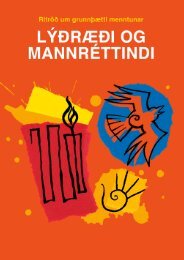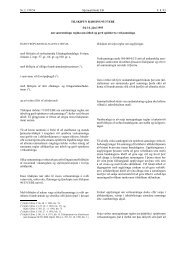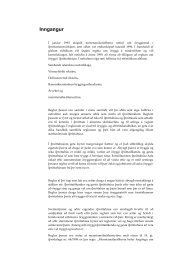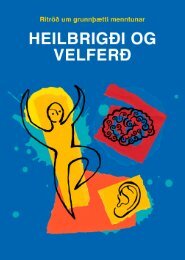Arts and Cultural Education in Iceland : Professor Anne Bamford
Arts and Cultural Education in Iceland : Professor Anne Bamford
Arts and Cultural Education in Iceland : Professor Anne Bamford
You also want an ePaper? Increase the reach of your titles
YUMPU automatically turns print PDFs into web optimized ePapers that Google loves.
Vignette 3.7.4 Every day there are m<strong>in</strong>iature miracles<br />
In what is really only one room, with a small office <strong>and</strong> wait<strong>in</strong>g area at one end, is the only Icel<strong>and</strong>ic music school the<br />
specialises <strong>in</strong> provid<strong>in</strong>g music for children <strong>and</strong> young people with special needs. There are only two <strong>and</strong> a half<br />
teachers’ positions <strong>and</strong> they work long days (8:30am-5:30pm) teach<strong>in</strong>g music to all the pupils <strong>in</strong> the school. They<br />
teach around 73 pupils <strong>and</strong> parents pay <strong>in</strong> the order of 7,000 to 12,000 ISK per month.<br />
The children suffer from a range of emotional, mental <strong>and</strong> physical disabilities. Some children’s health is so precarious<br />
that their parents only pay one month at a time. As the only music school of its type <strong>in</strong> the country, there is a long<br />
wait<strong>in</strong>g list (more than 50 pupils are on the wait<strong>in</strong>g list at the moment).<br />
The school was founded <strong>in</strong> 1987 by a piano teacher who had studied music therapy <strong>in</strong> the USA. She feels fortunate as<br />
she has been able to “shape the music school <strong>and</strong> has had the freedom to develop ideas.” Around 1/3 of the pupils<br />
are over 16 <strong>and</strong> there are some 3 <strong>and</strong> 4 year olds. The majority of pupils though are school children between the ages<br />
of 4-16. In addition to private lessons (usually 30-60m<strong>in</strong>utes <strong>in</strong> duration); the school offers a bell choir. Unlike other<br />
music schools, this music school does not experience a drop off <strong>in</strong> numbers as pupils reach teenage years, <strong>in</strong> fact most<br />
pupils like to stay <strong>in</strong> music school “forever”.<br />
They teach a range of music forms <strong>in</strong>clud<strong>in</strong>g s<strong>in</strong>g<strong>in</strong>g, piano, percussion <strong>and</strong> organ. One talented student now has a job<br />
play<strong>in</strong>g the organ <strong>in</strong> the church. The bell choir performs at various public <strong>and</strong> private occasions. There are Christmas<br />
<strong>and</strong> spr<strong>in</strong>g concerts. The teacher comments, “These are beautiful concerts. The pupils love be<strong>in</strong>g real musicians”<br />
The school runs five days a week.<br />
“We are develop<strong>in</strong>g a programme called Music Car<strong>in</strong>g”. It is a special way of work<strong>in</strong>g through “music<strong>in</strong>g”. Mothers<br />
br<strong>in</strong>g their very young children with disabilities. The mothers are full of sorrow <strong>and</strong> needs. It is a lived experience, <strong>and</strong><br />
I feel music car<strong>in</strong>g could provide a framework for early <strong>in</strong>tervention.” “We work with the <strong>in</strong>dividual not the label. We<br />
take the lead from the child. The music programme is def<strong>in</strong>ed by participants. We underst<strong>and</strong> what it is to care. Every<br />
day there are m<strong>in</strong>iature miracles <strong>and</strong> mov<strong>in</strong>g stories. A parent will say, “She was so calm” or “She always knows when<br />
it is Tuesday”. It is amaz<strong>in</strong>g, there seems to be no blockages when it comes to music.”<br />
The arts have also been effectively used to provide restorative care for young people who<br />
could be described as be<strong>in</strong>g ‘at risk’. Smaller schools accept<strong>in</strong>g these pupils commented that the<br />
arts made them “fit <strong>in</strong> quickly” <strong>and</strong> soon adapt to their new environment.<br />
The best th<strong>in</strong>g that can happen is to put special needs children <strong>in</strong>to the arts. I could show you problem children<br />
that really sh<strong>in</strong>e <strong>in</strong> the arts. They need to be given the opportunity to study arts. But it is difficult to get money to<br />
do this.<br />
The best students are the difficult children. The best th<strong>in</strong>g for them to do is art. Give them more opportunity to<br />
do arts.<br />
All the cultural agencies participat<strong>in</strong>g <strong>in</strong> a focus group had some special disability<br />
programmes. The Symphony <strong>in</strong>vites h<strong>and</strong>icapped people to a concert rehearsal twice a year.<br />
Hitthúsið – <strong>in</strong> cooperation with Art Without Borders – runs an art festival of h<strong>and</strong>icapped people.<br />
The National Museum of Icel<strong>and</strong> provides educational programmes which are coord<strong>in</strong>ated with<br />
the curricula of the students. All classes come to the Museum every other year. Admission for<br />
children is free. About 13.000 children come to the Museum annually. The situation has<br />
improved over the years <strong>and</strong> now students are com<strong>in</strong>g much more frequently. The Museum has<br />
organized programmes for students from pre-primary school through high school. The Museum<br />
has to serve all of Icel<strong>and</strong> as they expla<strong>in</strong>: “We have programmes <strong>and</strong> projects on the <strong>in</strong>ternet,<br />
free of charge for children <strong>and</strong> teachers. We're beg<strong>in</strong>n<strong>in</strong>g to focus on children with special<br />
needs; for example, a touch collection where bl<strong>in</strong>d children can come <strong>and</strong> touch object.” The<br />
Museum also has programmes for youth centres, especially dur<strong>in</strong>g summer. The National<br />
Theatre outl<strong>in</strong>ed their programmes; “We want to do a co-op with the deaf community; we've<br />
have already done some – done <strong>in</strong>troduction a couple of times before the plays which was<br />
sufficient for them to underst<strong>and</strong> the play. We also want to do a project with people who don't<br />
have Icel<strong>and</strong>ic as their native language.”<br />
77



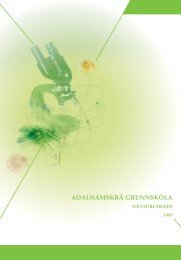
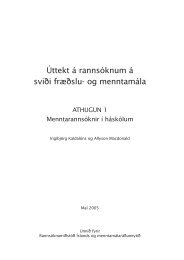

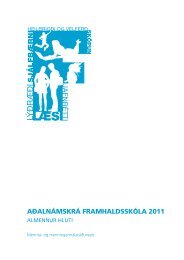
![Aðalnámskrá tónlistarskóla : rytmÃsk tónlist [Eingöngu á rafrænu formi]](https://img.yumpu.com/50843672/1/184x260/aaalnamskra-tanlistarskala-rytma-sk-tanlist-eingangu-a-rafranu-formi.jpg?quality=85)
